TNK has been publishing for 6 years now and I’ve never rounded up natural bug sprays or promoted a natural bug spray that “works for me”—and there’s a reason for that. Because they don’t. But that’s all about to change as we deep dive into an active bug spray ingredient that I’ve been curious about for a while: picaridin.

By: Lisa Fennessy
Meet the Expert
Reviewed by: Kate Noonan
Molecular Biologist and Cosmetic Chemist
Kate Noonan is a voted-in member of the Society of Cosmetic Chemists, the Society for Investigative Dermatology and the American Society for Microbiology. She loves her corgis, soccer and volunteering.
IN THIS POST:
- EPA approved insect repellents
- The problem with naturals
- What is picaridin?
- Is picaridin safe to use?
- What to look for (and avoid) in a picaridin bug repellant
- Picaridin repellents we are trying this summer
- References
I don’t know if it’s my blood type, my diet, my genetics (my nan was the same way) or what, but if there are bugs outside, they are on me. For example, Jason and I were walking back from dinner the other night and I go, “OMG, are there like a million bugs on me?” And he turns to look at me and just starts laughing because I LEGIT had 5 thousand bugs swarming my body. Not his. Mine!
So what’s a girl to do when I’m not keen on using DEET and naturals don’t work for me? Well, there are a couple other options actually. One specific option I’m trying this summer is called picaridin. But before we dive in, let’s take a look at the bigger picture.
EPA approved insect repellents
There are currently 6 EPA approved insect repellents. Choosing an Environmental Protection Agency (EPA) registered insect repellent ensures that it’s been tested for effectiveness and safety. Here they are in no particular order, plus our quick thoughts on each.
- DEET – the most common bug repellent. Concerns are carcinogenicity, cardiovascular toxicity and chest pain, and neurotoxicity (1–5).
- Picaridin (known as KBR 3023 and icaridin outside the US) – a synthetic created by Bayer in the 1980s. No major red flags.
- IR3535 – a synthetic similar to naturally occurring amino acid b-alanine, which has been used in Europe for more than 20 years. No major red flags.
- Oil of lemon eucalyptus (OLE) – naturally occurring. No major red flags.
- Para-menthane-diol (PMD) – PMD is the naturally occurring molecule and active ingredient in “Oil of Lemon Eucalyptus, Eucalyptus citriodora”…and it can also be manufactured synthetically. No major red flags.
- 2-undecanone – can be found naturally in many plants such as cloves, strawberries and tomatoes. Also called methyl nonyl ketone. No major red flags.
RELATED: How to read sunscreen labels.
The problem with naturals
Like me, maybe you are wondering, what about essential oils???
The only botanically derived ingredient the CDC recommends is oil of lemon eucalyptus/PMD, which has been registered with the EPA and has undergone efficacy testing.
Not to say essential oils don’t work. But they just don’t work as well. They evaporate off the skin quickly and wear off fast (10 & 11). And since the qualitative (my personal) testing and the scientific research aren’t there, I’m not recommending any natural bug spray, officially.
RELATED: Why natural ingredients aren’t always better than synthetics.
What is picaridin?
Picaridin is a synthetic mosquito and tick repellant in the piperidine compound family. The piperidine family includes natural black pepper compounds piperidine, piperine, piperettine and piperanine.
Research suggests that picaridin repels mosquitoes by masking a human’s scent, which mosquitoes can otherwise smell from ~170 feet away (6).
Is picaridin safe to use?
Picaridin is deemed safe by the EPA and recommended by the CDC. It’s also recommended for use by the EWG.
To dig a little deeper, we checked in with Kate Noonan, molecular biologist and cosmetic chemist for her take. She says, “Picaridin has a strong safety profile (5–9). It outperforms DEET and isn’t a neurotoxicant and cardiovascular toxicant like DEET” (1–4).
To illustrate, the following graph depicts the efficacy of popular bug repellents in relation to each other. It’s obvious that DEET (orange line) is the most effective bug repellent, but what’s interesting to note is that picaridin (red line) is pretty comparable and even out performs DEET at one point in this study.
It’s also interesting to note that citriodiol (the dark blue line, AKA oil of lemon eucalyptus [with the active ingredient PMD]) way out-performs citronella, which is touted as an effective repellent in the natural space and used by popular brands like Mosquito Guard, Kinfield Golden Hour Bug Repellent and Babyganics Natural Insect Repellent.
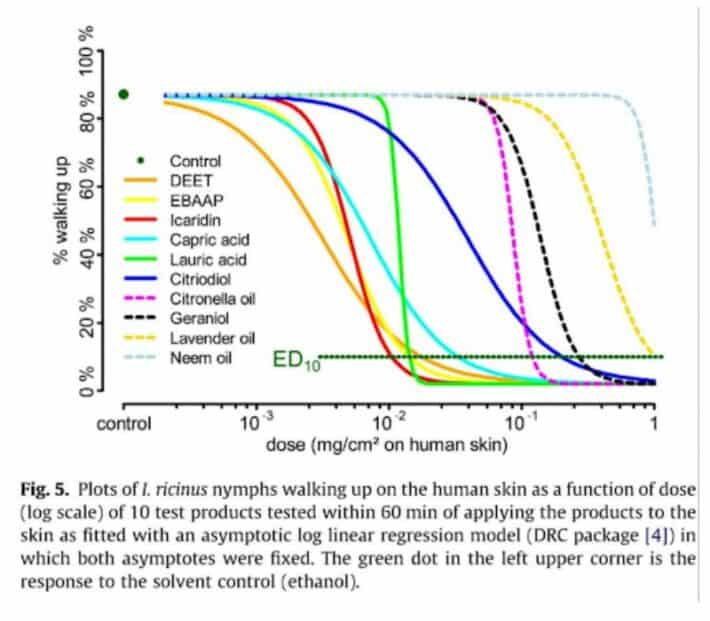
Kate continues, “Oil of lemon eucalyptus has been working [for me] in California, but I’ll use picaridin in tropical places with dengue fever and malaria.”
Me? Count me in for all of it! I’ll try oil of lemon eucalyptus, I’ll try picaridin, just give me something that works!
RELATED: The best alternatives to CeraVe cleansers.
What to look for (and avoid) in a picaridin bug repellant
So picaridin is the active ingredient that actually repels bugs, but we also need to consider the inactive ingredients in a formula (same as sunscreen). Picaridin is recommended to be used in 5-20% by the CDC, which means the inactive ingredients will make up 80-95% of most formulas.
So the next logical question to ask is, what’s in that 80-95%?
We’ve scoured the internet and narrowed down our top picks for picaridin bug repellents. All of these use picaridin as an active ingredient in 5-20% recommended by the CDC and are formulated with TNK-approved inactive ingredients (AKA none of these!).
And, by the way, this was not an easy task because it’s REALLY HARD to nail down ingredient lists here—they are rarely listed on the brand’s website, and not often even listed on the product packaging! Plus, even when we reached out to brands to ask for a full list, many responded that the formula was proprietary. 👇
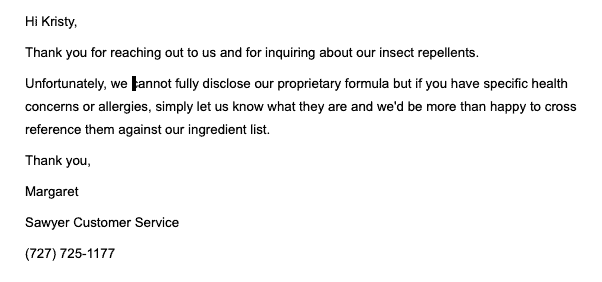
So we sent them our NO THANKS LIST and this is what we got back:
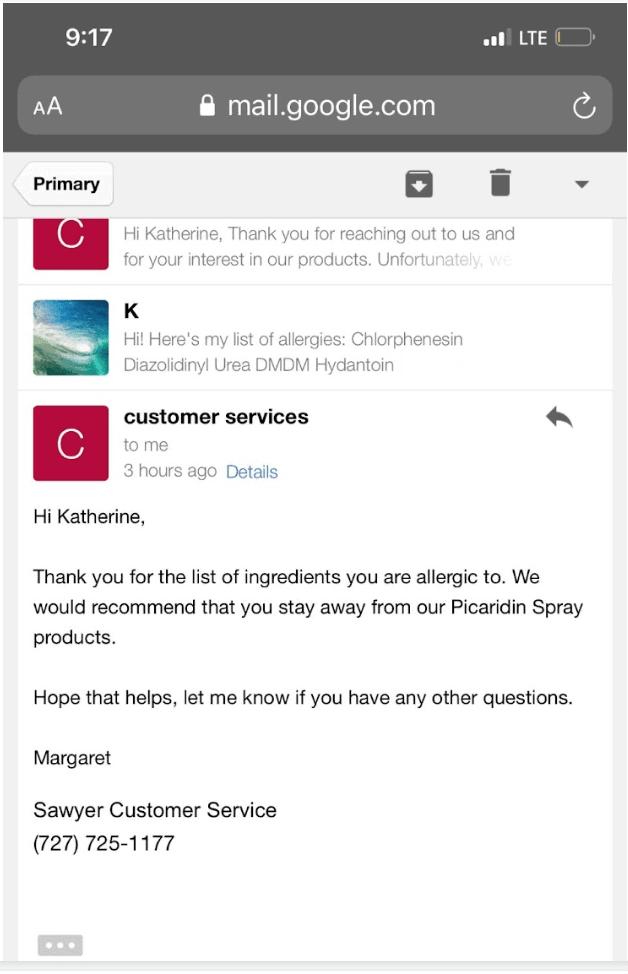
Kate speculates that all the EPA registered pesticide/bug repellant formulas don’t publish ingredients because it gives them an edge on competing products. They don’t want their formulas copied and listing their ingredients opens them up to that. AND, they are not required to list them like cosmetic companies are, so why would they?
The other part of the problem is many green or holistic companies have not adopted picaridin yet, so it’s not as easy as finding, let’s say, a mineral sunscreen without synthetic fragrance, for example.
Picaridin repellents we are trying this summer
It’s interesting to note that OFF! (owned by SC Johnson) is (WOW) transparent with their ingredients. We called them and they have all their ingredients listed online.
Two of their products made our recommendations list. Just don’t get these confused with the aerosol versions which have 20-30% butane and isobutane propellant, which is a NO for us.
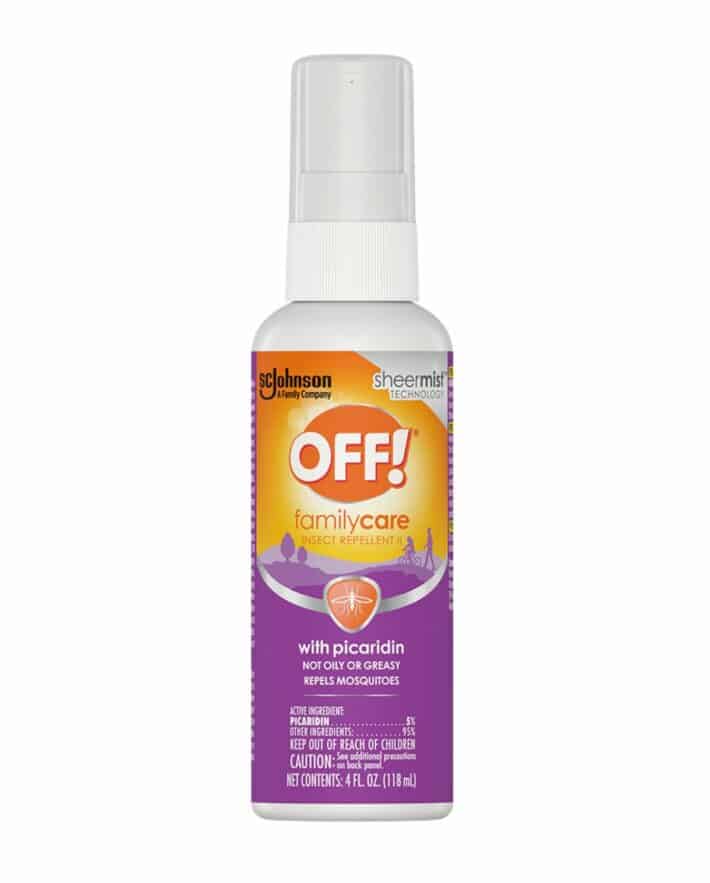
OFF!® Family Care Insect Repellent II with Picaridin | $11.50
Ingredients: 5% picaridin, water, ethanol, citric acid.
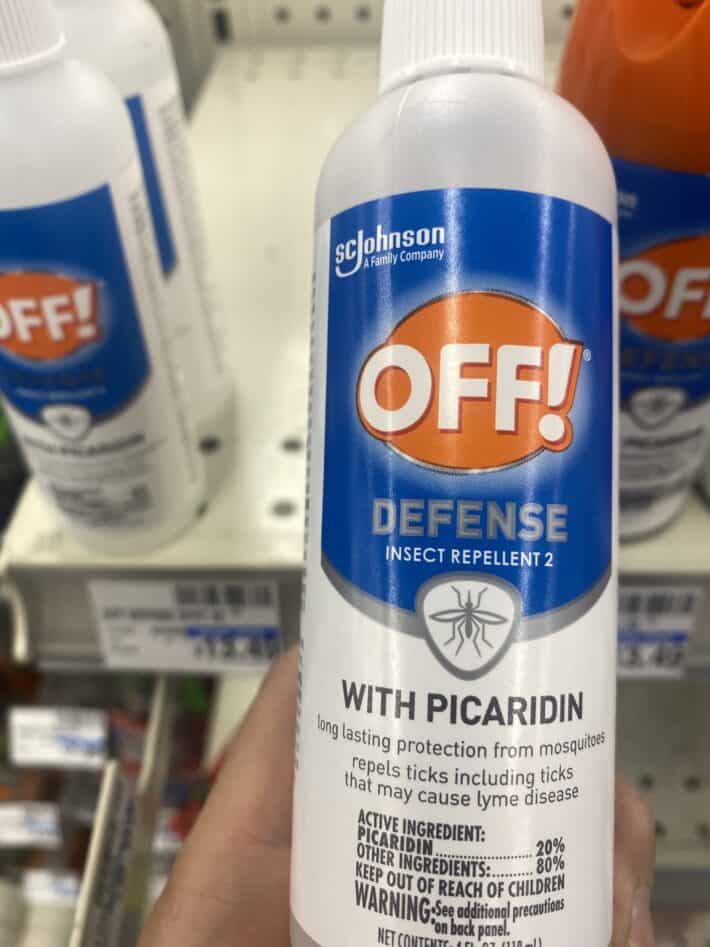
OFF!® Defense Insect Repellent 2 with Picaridin | $13
Ingredients: 20% picaridin, 80% water, ethanol and citric acid (lasts 12 hours).
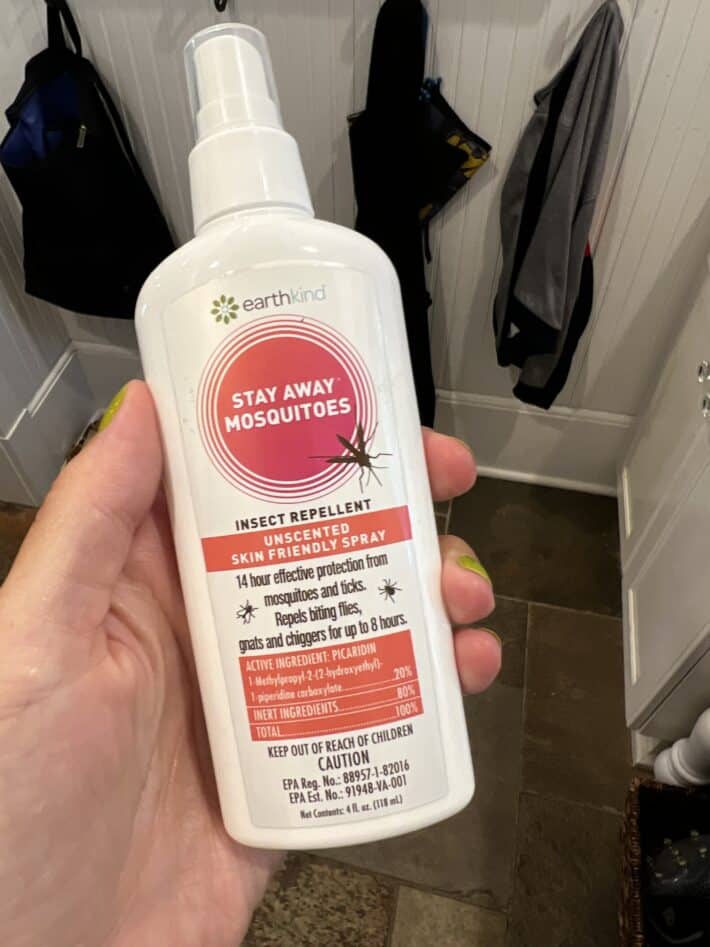
EarthKind Stay Away Mosquitoes | $10
Via email response: The active ingredient is 20% picaridin, the inert ingredients include ethanol, glycerine and water. Please reference our Safety Data Sheet for a list of ingredients within the formulation as supplied by the original registrant.
Have you tried any picaridin-based bug sprays? What’s working for you?

TNK Team Note: This article contains affiliate links. TNK uses affiliate links as a source for revenue to fund operations of the business and to be less dependent on branded content. TNK stands behind all product recommendations. Still have questions about these links or our process? Feel free to email us.
References
1. Tisch M., Schmezer P., Faulde M., Groh A., Maier H.; Genotoxicity studies on permethrin; DEET and diazinon in primary human nasal mucosal cells; European Archives of Oto-rhino-laryngology, 2002 Mar; 259(3):150-3. (DEET is genotoxic)
2. Clem J.R., Havemann D.F., Raebel M.A.; Insect repellent (N, N-diethyl-m-toluamide) cardiovascular toxicity in an adult; Annals of Pharmacotherapy, 1993 Mar; 27(3):289-93. (DEET is a cardiovascular toxicant)
3. Legeay S., Clere N., Apaire-Marchais V., Faure S., Lapied B.; Unusual modes of action of the repellent DEET in insects highlight some human side effects; European journal of pharmacology, 2018 Apr 15; 825:92-8. (DEET is a neurotoxicant)
4. Corbel V., Stankiewicz M., Pennetier C., Fournier D., Stojan J., Girard E., Dimitrov M., Molgó J., Hougard J.M., Lapied B.; Evidence for inhibition of cholinesterases in insect and mammalian nervous systems by the insect repellent deet; BMC biology, 2009 Dec;7(1):1-1. (DEET is a neurotoxicant)
5. Afify A., Betz J.F., Riabinina O., Lahondère C., Potter C.J.; Commonly used insect repellents hide human odors from Anopheles mosquitoes; Current Biology, 2019 Nov 4;29(21):3669-80. (Picaridin mechanism article)
6. Feuser, Z.P.; Colonetti, T.; Grande, A.J.R.U.; Maria, L.; Roever, L.; da Rosa, M.I. Efficacy of the DEET, IR3535, and Picaridin Topical Use Against Aedes Aegypti: Systematic Review. Infect. Dis. Clin. Pract. 2020, 28, 327–341. (Picaridin efficacy beats DEET)
7. MaryamTavassoli M.S., Hassan Vatandoost M., Abai R., Khoobdel M., Bakhshi H., Rafi F; Repellency effects of picaridin and DEET against Anopheles stephensi on human volunteers; J Entomol Zool Stud 2015;3:343-7. (Picaridin efficacy beats DEET)
8. Zakama A.K., Gaw S.L.; Malaria in Pregnancy: What the Obstetric Provider in Nonendemic Areas Needs to Know; Obstet Gynecol Surv. 2019 Sep; 74(9):546-556. doi: 10.1097/OGX.0000000000000704. PMID: 31830300; PMCID: PMC7560991.
9. Sangha, G.K Toxicology and Safety Evaluation of the New Insect Repellent Picaridin (Saltidin). In: Kreiger R Ed. Hayes’ Handbook of Pesticide Toxicology. New York, Academic Press (2010).
10. Pollack, R., Kiszewski, A. Spielman, A.; Repelling Mosquitoes; July 4, 2002; New England Journal of Medicine 2002; 347:2-3; DOI: 10.1056/NEJM200207043470102.
11. Maia M.F.; Moore S.J.; Plant-based insect repellents: a review of their efficacy, development and testing; Malar J. 2011 Mar 15; 10 Suppl 1(Suppl 1):S11. doi: 10.1186/1475-2875-10-S1-S11. PMID: 21411012; PMCID: PMC3059459.




Emma
August 15, 2022I use Jao Brand Patio Oil and feel like it works really well – just checked, and it uses lemon eucalyptus oil instead of citronella. There are also a couple spray options. And the last time I reached out about something (ordering hand sanitizer at the beginning of the pandemic) the customer service was SO nice.